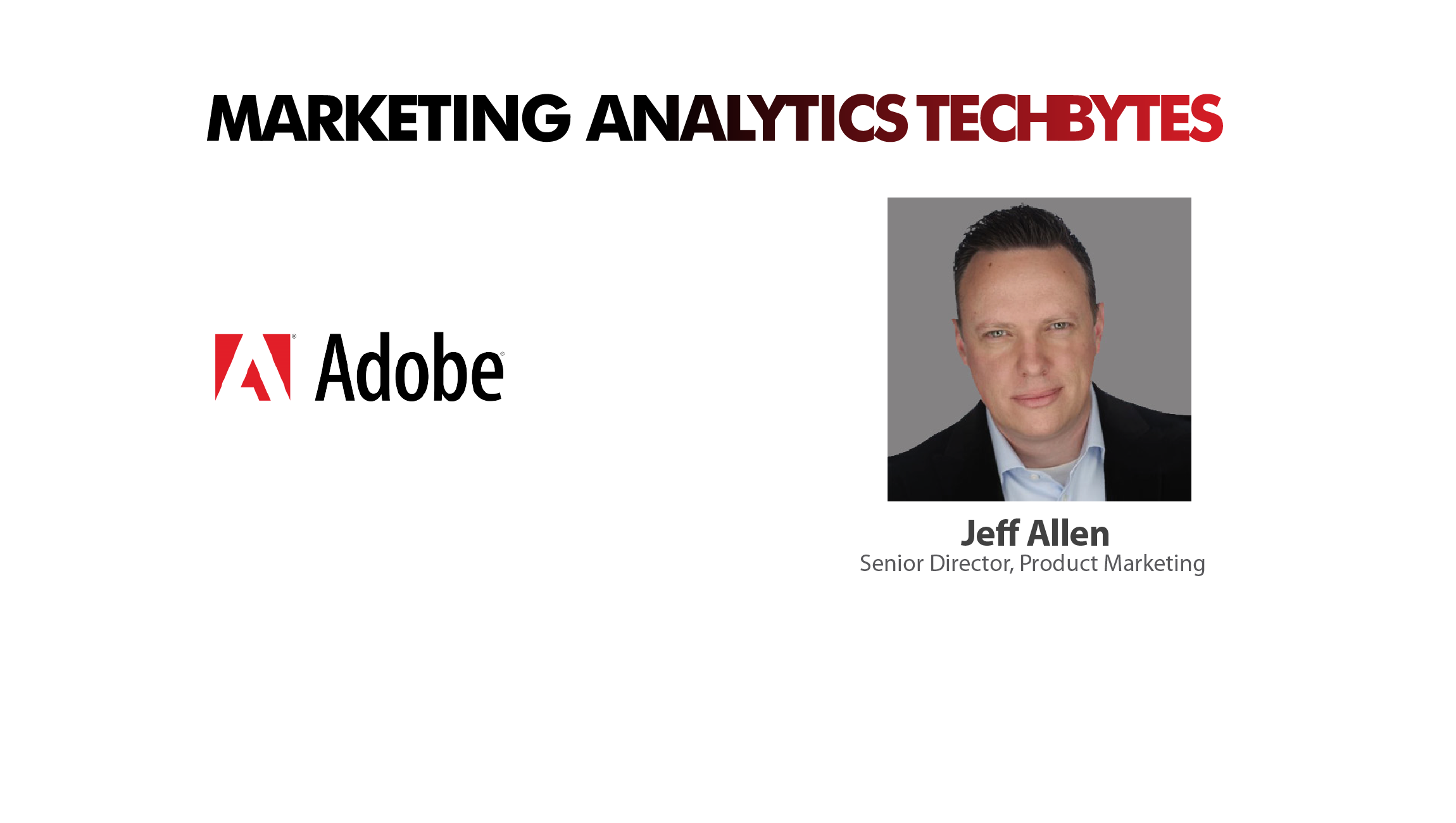Jeff Allen
Senior Director, Product Marketing, Adobe
Adobe Analytics is a guiding solution for enterprises to build their existing datasets into impeccable customer intelligence insights. With data, there is always the complexity of scale, relevance and ROI, attached. How should enterprises juggle between multi-channel data streams for insights and actions into customer behavior and experience? The firepower behind the customer intelligence used by two-thirds of the Fortune 100, Adobe Analytics empowers modern CMOs in quick decision-making at an unmatched scale. To understand how Adobe Analytics stacks up into a modern CMO’s martech investment list and the applications of advanced AI/ML capabilities for customer intelligence, we spoke to Jeff Allen, Senior Director, Product Marketing, Adobe Analytics.
Html code here! Replace this with any non empty text and that's it.
MTS: Tell us about the evolution of Adobe Analytics and how it fits into a modern CMO’s martech stack?
Jeff Allen: Analytics in the marketing world has evolved dramatically over the last two decades. The analytics market has evolved from being a function centrally delivered in marketing operations inside IT-function called Business Intelligence. Most lines of business would come to the BI team for access to data and sometimes for advanced analysis. At Adobe, we saw that with the explosion of marketing technology, which was brand new phenomenon for most CMOs in the last two decades, the requirements to build a digital business driven by analytics also grew.
We have been on this journey for 10 years now, starting with Adobe Marketing Cloud, which was reimagined as the Adobe Experience Cloud this year.
If you look at Fortune 500 list, you will find that the majority of the top 10 media, banking and financial services, telecom, travel and hospitality, technology, service providers, retailing and apparel, insurance, and automotive firms, leverage Adobe Analytics. We are the world’s largest web and digital analytics company, and we continue to consolidate our position as a scalable, lightning-fast customer-focused company.
At Adobe, we have three major lines of business –
- Adobe Creative Cloud where all our premium creative tools and technologies reside
- Adobe Document Cloud where all our primary document signing and workflow management tools reside
- Adobe Experience Cloud which includes the enterprise version of both Creative and Document Cloud, in addition to three other sub-categories: Adobe Marketing Cloud, Adobe Advertising Cloud, and the Adobe Analytics Cloud
So, the Adobe Experience Cloud forms the primary backbone of any business today and the three categories add to build the primary objective of creating and delivering experiences that matter to the customers. The Adobe Experience Cloud is really the collection of capabilities that helps businesses deliver meaningful experiences. Certainly, you can’t create experiences if you don’t have intelligence, measurement, and analytics, driving those experiences. The focus is to build the analytics that your customers want and how you deliver that to them.
We announced Adobe Analytics Cloud using two existing technologies—Adobe Analytics and Adobe Audience Manager. Adobe Analytics is the measurement and analytics product line, while Adobe Audience Manager is our Data Management Platform (DMP).
Today, marketing teams have access to diverse analytics stacks within marketing technology. If you look at marketing, ad tech, digital and mobile app analytics, you would realize that the start of analytics could be attributed to web analytics.
Web analytics is usually the starting point for measurement in digital marketing and pretty quickly that industry grew beyond just being a web-centric industry. We started measuring every aspect of digital marketing analytics and that continued to expand into offline channels that marketing was doing generally. Today, web analytics has expanded to become a mix of marketing analytics and customer intelligence.
Adobe has played a major role in each of these evolutions of marketing analytics technologies, right through its journey from the web to digital, to marketing, to customer intelligence. Today, Adobe Analytics provides measurement technologies for the web, mobile, social, video, advertising and offline channels as well. So, we have managed to differentiate ourselves from the rest in the market at all levels of offline and digital analytics.
MTS: What are your unique offerings that make using data much easier and scalable?
Jeff: Our unique offerings are:
- Tool-within-Tool Product Experience
We offer an impeccably refined level of in-depth analysis with our analytics tools. Our tool-within-tool enables customers to undertake deep segmentation of data. This means you can drill down indefinitely into tiny data-defined segments.
- Scalable Integration with Other Technologies and Platforms
Scaling Adobe Analytics is easy and productive as you can act on data segments using a technology integrated with the DMP, targeting and behavioral personalization platforms and more.
Historically, we have always stood out in the way we offered analytics to marketing teams. More recently we developed Analysis Workspace, a powerful technology to democratize access to analytics. Workspace allows you to bring data into the workspace like you would bring imagery onto the creative palette of Photoshop. Using Workspace, you can drag-and-drop data tables, visualization, and components, helping you derive a clear insight into how your workflow looks through diverse experiences of people in the organization.
MTS: How does Adobe Analytics engine work discretely for marketing, sales, and customer intelligence?
Jeff: If you look at different martech categories, a modern CMO uses over a dozen tools for various purposes—email marketing, commerce and sales, social and relationship management, content experience, advertising and promotion and more.
For example, initially, the market of email service providers decided how and why marketing analytics should be embedded inside of email marketing tools. If I am using a tool to measure email marketing performance, I should be able to measure every metric related to a customer within the same product dashboard. With Adobe Campaign, the analytics experience for the email marketer (user) resides within the product itself and needs no additional buy-ins.
For categories like mobile apps, mobile web, or content experience management systems, the users (marketers) expect to use the tool directly from the Analytics product. Adobe Analytics delivers just that by embedding within Adobe Campaign, Target, and Adobe Social. It is central destination of analytics tool that satisfies the need of an email marketer who is not a data analyst as well as that of the primary analytics team who are measuring the entire customer journey based on purview of the online-offline touchpoints.
MTS: How do you add Programmatic Capabilities to Adobe Analytics?
Jeff: Fancy word for automation—that’s programmatic! Automation offers you scale; programmatic with analytics does the same if you do it at a continuous level in the advertising ecosystem. With Adobe Advertising Cloud, programmatic engine runs on the insights from Adobe Analytics. The Adobe Advertising Cloud for programmatic runs on the two vectors—timed insights and timed actions. These two vectors play the whole game around the Adobe Analytics engine. Under the hood, it’s all data science. In the context of programmatic, the job of analytics is to provide the insights on time and deliver in a highly refined manner for the best experiences.
MTS: How do you see recommendation engines for B2B and B2C e-market evolving with matured predictive intelligence and ML?
Jeff: Major investments in AI/ML and predictive intelligence from Adobe have been occurring for a very long time, not just in Analytics but in other technology stacks too. Our technology leverages Adobe Sensei, which powers intelligent features across all Adobe products. Adobe Experience Cloud uses dozens of ML/AI within Adobe Sensei. At Analytics, if you are looking at web data, it would be a complex set. Having AI/ML reduced human effort, delivering accurate as well as corrective measures about web experience of audience, much faster. Anomaly detection and correction becomes quicker with AI/ML used in analytics.
Mere discovery of anomalies requires a bunch of experts and a large team who would study the combination of data science in metrics, segments and dimension to see what caused anomaly in the first place.
MTS: What are the challenges you foresee in adoption of AI/ML technologies? How does Adobe Analytics enable businesses to overcome these challenges?
Jeff: In the marketing technology world, timing and relevance is everything. The idea of building centralized AI/ML tools for general purposes is very over-simplified. The buzz around Big Data may have over-simplified the way businesses see challenges in working with data. The challenges to working with data are multi-dimensional. Onboarding, collecting, extracting, loading, encrypting, decrypting, managing and transforming data – there are challenges at every step with working with tools and utilities. And then, there are security and governance issues in the way data is mined and used.
Until you have the data management process in place, scaling and speeding AI/ML would prove futile. So, the biggest challenge is to get data ingested into the system that can drive powerful algorithms, move up the stack to run prescription and prediction, and conventionally develop theories and get to the idea of prescriptive action.
Frankly, we talk to customers that the need of the hour is to move away from being descriptive and diagnostic in their approach to analytics and move up to adapt prescriptive-predictive methodologies. The organizations that are able to do it are invariably successful at working with prescriptive and predictive intelligence. For marketing teams, Adobe built special infrastructure that gets analytics faster, almost instantaneously.
MTS: What’s the next-frontier for marketers in customer experience and audience engagement?
Jeff: The impact of Adobe Sensei on Adobe Analytics is incredible. We are advancing towards predictive and prescriptive analytics based on the low-scale specification of usage. The purpose of deploying AI/ML is not just to get things done fast, but also do it in way that is easy to use at every level of the organization. It is expected that organization would work better—but that’s hard thing to achieve. Adobe Analytics helps bridge the gap. While customer needs are simpler, the insights about their experiences and engagements are complex. With simpler user experience, Adobe Analytics quickly analyzes the complex parts of customer data. Adobe Sensei is at the core of all our technology stack, enabling high-level visualization, recommendation, segmentation and learning systems to deliver scale.
MTS: Thanks for chatting with us, Jeff.
Stay tuned for more insights on marketing technologies. To participate in our Tech Bytes program, email us at news@martechseries-67ee47.ingress-bonde.easywp.com












Comments are closed.